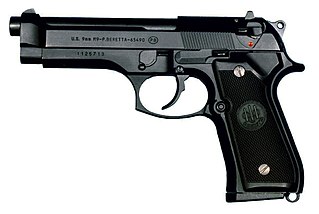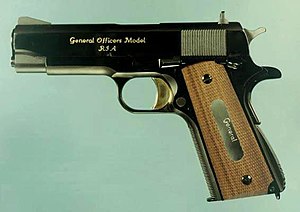
The Browning Hi-Power is a single-action, semi-automatic handgun available in the 9mm and .40 S&W calibers. It was based on a design by American firearms inventor John Browning, and completed by Dieudonné Saive at Fabrique Nationale (FN) of Herstal, Belgium. Browning died in 1926, several years before the design was finalized. FN Herstal initially named the design the "High Power", which alludes to the 13-round magazine capacity, almost twice that of other designs at the time, such as the Luger or Colt M1911.

The M1911, also known as Colt 1911, or Colt Government, is a single-action, semi-automatic, magazine-fed, recoil-operated pistol chambered for the .45 ACP cartridge. The pistol's formal designation as of 1940 was Automatic Pistol, Caliber .45, M1911 for the original model of 1911 or Automatic Pistol, Caliber .45, M1911A1 for the M1911A1, which was adopted in 1924. The designation changed to Pistol, Caliber .45, Automatic, M1911A1 in the Vietnam War era.

A derringer is a small handgun that is neither a revolver nor a semi/fully automatic pistol. It is not to be confused with mini-revolvers or pocket pistols, although some later derringers were manufactured with the pepperbox configuration. The modern derringer is often multi-barreled, and is generally the smallest usable handgun of any given caliber and barrel length due to the lack of a moving action, which takes up more space behind the barrel. It is frequently used by women because it is easily concealable in a purse or a stocking.

The .45 ACP or .45 Auto (11.43×23mm) is a rimless straight-walled handgun cartridge designed by John Moses Browning in 1904, for use in his prototype Colt semi-automatic pistol. After successful military trials, it was adopted as the standard chambering for Colt's M1911 pistol. The round was developed due to a lack of stopping power experienced in the Moro Rebellion in places like Sulu. The issued ammunition, .38 Long Colt had proved inadequate, motivating the search for a better cartridge. This experience and the Thompson–LaGarde Tests of 1904 led the Army and the Cavalry to decide that a minimum of .45 caliber was required in a new handgun.

The Nambu pistols are a series of semi-automatic pistols produced by the Japanese company Koishikawa Arsenal, later known as the Tokyo Artillery Arsenal. The series has three variants, the Type A, the Type B, and the Type 14. The Nambu pistols were designed to replace Japan's earlier service pistol, the Type 26 revolver.

The Heckler & KochP7 is a German 9×19mm semi-automatic pistol designed by Helmut Weldle and produced from 1979 to 2008 by Heckler & Koch GmbH (H&K). It was revealed to the public for the first time in 1976 as the PSP. The P7M13, a variant of the P7 with a double-stack magazine, was produced until 2000, and was unsuccessfully submitted to the U.S. Army XM9 pistol trials as a replacement for the M1911 pistol.

The Type 26 or Model 26 "hammerless" revolver was the first modern revolver adopted by the Imperial Japanese Army. It was developed at the Koishikawa Arsenal and is named for its year of adoption in the Japanese dating system. The revolver saw action in conflicts including the Russo-Japanese War, World War I and World War II.

The Beretta M9, officially the Pistol, Semiautomatic, 9mm, M9, is the designation for the Beretta 92FS semi-automatic pistol used by the United States Armed Forces. The M9 was adopted by the United States military as their service pistol in 1985.

In American English, a pocket pistol is any small, pocket-sized semi-automatic pistol, and is suitable for concealed carry in either a coat, jacket, or trouser pocket.

The FN Model 1910 is a blowback-operated, semi-automatic pistol designed by John Browning and manufactured by Fabrique Nationale of Belgium.

The Colt Model 1903 Pocket Hammerless is a .32 ACP caliber, self-loading, semi-automatic pistol designed by John Browning and built by Colt Patent Firearms Manufacturing Company of Hartford, Connecticut. The Colt Model 1908 Pocket Hammerless is a variant introduced five years later in .380 ACP caliber. Despite the title "hammerless", the Model 1903 does have a hammer. The hammer is covered and hidden from view under the rear of the slide, this allows the pistol to be carried in and withdrawn from a pocket quickly and smoothly without snagging.

The Colt Model 1900 is a short-recoil operated "self-loading", or semi-automatic .38 caliber handgun introduced by Colt's Manufacturing Company at the turn of the 20th century. It also marked the introduction of .38 ACP, the round for which it is chambered, and was the first handgun to utilize short-recoil operation.

The MEU(SOC) pistol, officially designated the M45 MEUSOC, is a magazine-fed, recoil-operated, single-action, semiautomatic pistol chambered for the .45 ACP cartridge. A variant of the M1911, it has been the standard-issue side arm for the Force Recon Element of the United States Marine Corps' Marine Expeditionary Units since 1985. It is assigned NATO Stock Number 1005-01-370-7353.

A handgun is a short-barrelled firearm that can be held and used with one hand. The two most common handgun sub-types in use today are revolvers and semi-automatic pistols, although other handgun-types such as derringers and machine pistols also see infrequent usage.
The Colt Model 1903 Pocket Hammer was a short-recoil, semi-automatic pistol, designed by the American arms designer John Browning. It was a compact version of the Colt Model 1902 Sporting Model pistol derived from the original Colt M1900. The Colt M1902 Sporting Model and 1903 Pocket Hammer model have significant differences to the military-inspired Colt 1902 Military Model although they fire the same cartridge. Its design is in no way related to the Colt Model 1903 Pocket Hammerless or the FN Model 1903 pistol.

Astra Unceta y Cía was a Spanish weapons manufacturer founded on July 17, 1908, under the name Esperanza y Unceta by Juan Esperanza and Pedro Unceta. Initially based in Eibar, the centre of the Basque arms industry, the company moved in 1913 to Guernica.
Llama Firearms, officially known as Llama-Gabilondo y Cia SA, was a Spanish arms company founded in 1904 under the name Gabilondo and Urresti. Its headquarters were in Eibar in the Basque Country, Spain, but they also had workshops during different times in Elgoibar and Vitoria. The company manufactured moderate-priced revolvers and self-chambering pistols in a wide variety of models. These were popular mainly in the European and Latin American export market, as well as domestically in Spain.

The Astra modelo 400 was a Spanish service pistol produced by weapons manufacturer Astra-Unceta y Cia SA. as a replacement for the Campo-Giro 1913/1916, which had also been chambered in 9mm Largo. It was the standard issue sidearm in the Spanish Army during the Spanish Civil War and also saw service in Germany during World War II.

The Colt Officer's Model or Colt Officer's ACP is a single-action, semi-automatic, magazine-fed, and recoil-operated handgun based on the John M. Browning designed M1911. It was introduced in 1985 as a response from Colt to numerous aftermarket companies making smaller versions of the M1911 pistol.

The Arsenal Firearms AF2011-A1 is a double-barreled, semi-automatic pistol of Italian origin. The weapon is a derivative of the M1911 pistol and the majority of internal parts including the firing pins, firing pin plates, sear groups, springs, recoil rods, and mainspring housings are interchangeable with standard M1911 replacement parts. The purpose of the AF2011A1 pistol is to increase the ballistic capability of .45 ACP without the need to develop a more powerful round. The AF2011A1 has its roots in the Grieco pistol that also came with double barrels for the same purpose.


















